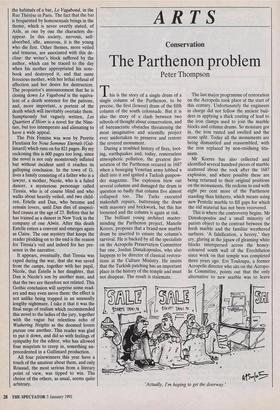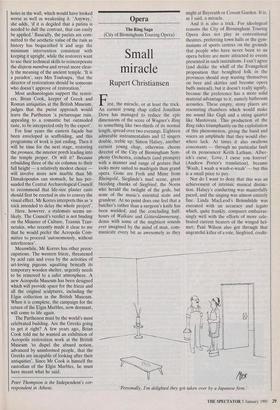ARTS
Conservation
The Parthenon problem
Peter Thompson
This is the story of a single drum of a single column of the Parthenon, to be precise, the first (lowest) drum of the fifth column of the south colonnade. But it is also the story of a clash between two schools of thought about conservation, and of bureaucratic obstacles threatening the most imaginative and scientific project ever undertaken to preserve and restore the revered monument.
During a troubled history of fires, loot- ing, earthquakes and, today, remorseless atmospheric pollution, the greatest ilev- astation of the Parthenon occured in 1687 when a besieging Venetian army lobbed a shell into it and ignited a Turkish gunpow- der magazine. The explosion blew out several columns and damaged the drum in question so badly that column five almost collapsed too. The Turks executed makeshift repairs, buttressing the drum with masonry and brickwork, but this has loosened and the column is again at risk.
The brilliant young architect master- minding the Parthenon project, Manolis Korres, proposes that a brand-new marble drum be inserted to ensure the column's survival. He is backed by all the specialists on the Acropolis Preservation Committee bar one, Jordan Dimakopoulos, who also happens to be director of classical restora- tions at the Culture Ministry. He insists that the Turkish patching has an important place in the history of the temple and must not disapear. The result is stalemate. The last major programme of restoration on the Acropolis took place at the start of this century. Unfortunately the engineers in charge did not follow the ancient buil- ders in applying a thick coating of lead to the iron clamps used to join the marble blocks and column drums. So moisture got in, the iron rusted and swelled and the stone split. Today all the monuments are being dismantled and reassembled, with the iron replaced by non-oxidising tita- nium.
Mr Korres has also collected and identified several hundred pieces of marble scattered about the rock after the 1687 explosion, and where possible these are being returned to their original positions on the monuments. He reckons to end with eight per cent more of the Parthenon standing than hitherto, which means using new Pentelic marble to fill gaps for which the old material has not been recovered.
This is where the controversy begins. Mr Dimakopoulos and a small minority of purists object to the contrast between the fresh marble and the familiar weathered surfaces. 'A falsification, a heresy,' they cry, glaring at the jigsaw of gleaming white blocks interspersed across the honey- coloured south wall of the Erechtheion since work on that temple was completed three years ago. Evi Touloupa, a former Acropolis director who sits on the Acropo- lis Committee, points out that the only alternative to new marble was to leave `Actually, I'm hoping to get the doorway.' holes in the wall, which would have looked worse as well as weakening it. 'Anyway,' she adds, 'if it is dnided that a patina is needed to dull the contrast, that can easily be applied.' Basically, the purists are com- mitted to the aesthetic value of the ruin as history has bequeathed it and urge the minimum intervention consistent with keeping it upright, while the restorers want to use their technical skills to reincorporate the disjecta membra and reveal more clear- ly the meaning of the ancient temple. 'It is a paradox', says Mrs Touloupa, 'that the director of restorations should be someone who doesn't approve of restoration.'
Most archaeologists support the restor- ers. Brian Cook, keeper of Greek and Roman antiquities at the British Museum, judges that the purist approach would leave the Parthenon 'a picturesque ruin, appealing to a romantic but outmoded taste, to be interpreted only by the expert'.
For four years the eastern fagade has been enveloped in scaffolding, and this programme of work is just ending. Then it will be time for the next stage, restoring the pronaos, the interior porch leading into the temple proper. Or will it? Because rebuilding three of the six columns to their full height — a relatively modest choice will involve more new marble than Mr Dimakopoulos can stomach, he has per- suaded the Central Archaeological Council to recommend that life-size plaster casts should first be erected in situ to convey the visual effect. Mr Korres interprets this as 'a trick intended to delay the whole project'.
Here, however, a stalemate seems un- likely. The Council's verdict is not binding on the Minister of Culture, Tzannis Tzan- netakis, who recently made it clear to me that he would prefer the Acropolis Com- mittee to proceed 'autonomously, without interference'.
Meanwhile, Mr Korres has other preoc- cupations. The western frieze, threatened by acid rain and even by the activities of art-loving pigeons squatting beneath its temporary wooden shelter, urgently needs to be removed to a safer atmosphere. A new Acropolis Museum has been designed which will provide space for the frieze and all the original sculptures, including the Elgin collection in the British Museum. When it is complete, the campaign for the return of the Elgin Marbles, now dormant, will come to life again.
The Parthenon must be the world's most celebrated building. Are the Greeks going to get it right? A few years ago, Brian Cook told me he wanted an exhibition of Acropolis restoration work at the British Museum 'to dispel the absurd notion, advanced by uninformed people, that the Greeks are incapable of looking after their antiquities'. Since Mr Cook is himself the custodian of the Elgin Marbles, he must have meant what he said.
Peter Thompson is the Independent's cor- respondent in Athens.











































 Previous page
Previous page